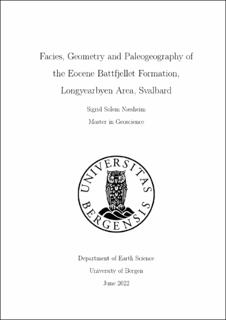| dc.description.abstract | This MSc thesis investigates the facies and architecture variability of the Paleogene Battfjellet Formation in the Longyearbyen area on Svalbard, with the aim to complement the regional framework of the formation. Together with the offshore to deep water mudstones of the Frysjaodden Formation and the continental Aspelintoppen Formation, the shallow-marine Battfjellet Formation comprises the eastwards-prograding infill of the foredeep flanking the West Spitsbergen fold-and- thrust belt in the Eocene. Centimeter-scale lithostratigraphic logging and facies analysis have been performed in eight well-exposed outcrop localities. Lithostratigraphic logs have been combined with digital outcrop models obtained from photogrammetry, which allowed an accurate correlation of major depositional boundaries and architectural reconstruction of the deposits in the study area. A total of twelve sedimentary facies have been distinguished, indicating deposition and re- working by wave-generated unidirectional currents and oscillatory flows. Six facies associations (FA) and sub-associations have been established, each reflecting distinctive depositional environments by grouping spatially and genetically coherent facies: offshore to offshore transition zone (FA1), lower shoreface (FA2), upper shoreface, and foreshore (FA3-A), tidal inlet (FA3-B), terminal distributary channels (FA3-C), and floodplain (FA4). Five parasequences (P0-P4) were recognized from vertical and lateral facies variability. The facies and parasequence stacking pattern indicate deposition in a fluvio-wave interaction shelf delta with a flat to ascending shoreline trajectory. The parasequences are interpreted to have been deposited by elongated deltaic lobes that switched frequently due to channel avulsion on the lower delta plain. The observed facies assemblage, geometries, and interpreted paleogeography essentially converge with previous studies, with some exceptions. Two main differences are observed in the study area: (i) there are fewer but thicker parasequences when compared to what has been documented further south, and (ii) well-developed clinoforms are not observed. The deviations are suggested to be linked to deposition in a ramp-like shelf setting with high aggradation rates. | |
